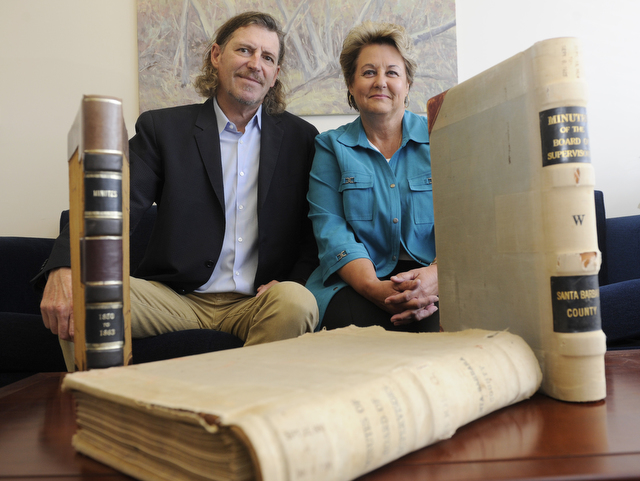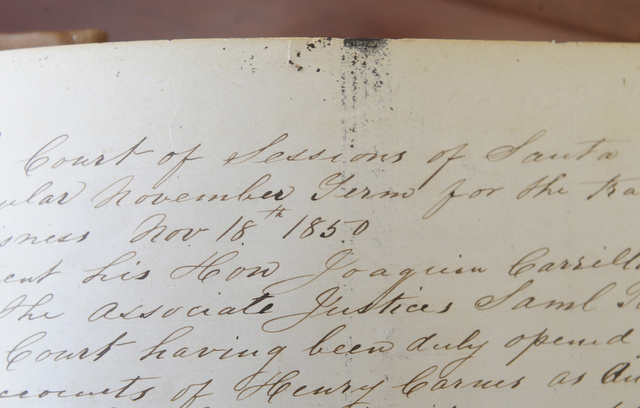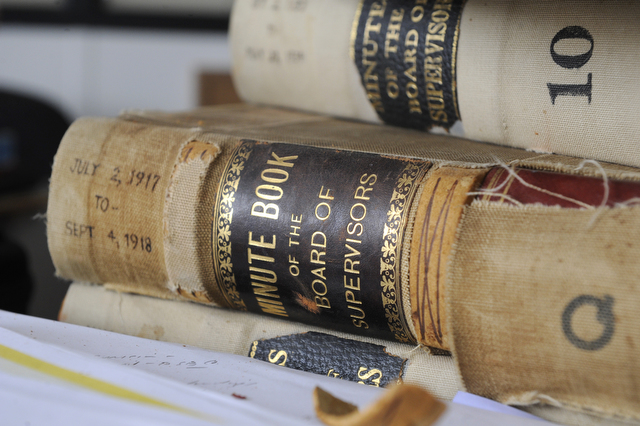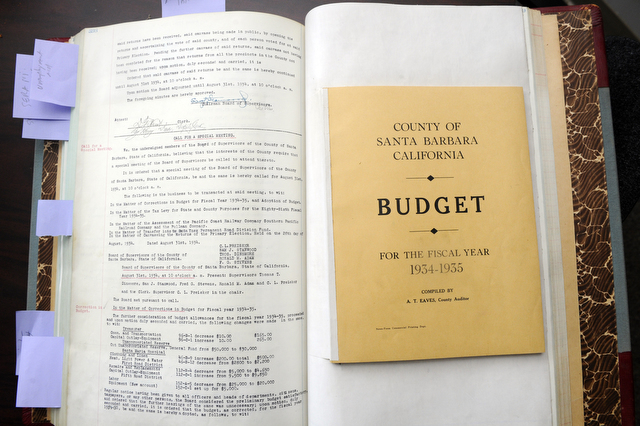County Archiving Handwritten History of Santa Barbara’s Early Days
Gallery Show Planned for July

At one of their first meetings, they paid someone $7 to place irons on Guadalupe Sanchez, a man who had been on the lam. The next few meetings were sporadic and somewhat less spicy, with three judges deliberating over ways to bring in tax revenue. The three judges were the Board of Supervisors of their day: it was the early 1850s and Santa Barbara County — and the State of California — had just been formed.
From November 18, 1850 — the first day of the county’s recorded history — to August 5, 1907, clerks of the board handwrote history in 16 hard-bound ledgers. From September 3, 1907 to April 4, 1977, the minutes were documented with a typewriter, spanning 199 similar hard-bound books. (After 1977, the Board of Supervisors’s minute books took the microfilm route, before going online in 2000.) Across those 215 books and 90,000 pages, the early days of Santa Barbara County played out.
In the early days, most meetings dealt with disbursement of money for orphans, “half-orphans,” people with disabilities, “needy aged persons,” and, after the Depression, people seeking unemployment benefits. During those times, illnesses like leprosy and tuberculosis were all too real, and Solvang was simply referred to as the “Danish-American colony.”

Yet as much as things have changed since, they have stayed the same. There are passages that touch on controversy over oil drilling, bids to widen roadways, and scuffles between the Supervisors and the Sheriff. Then there are the passages that note the purchase of the first county building, to rebuild the courthouse after the 1925 earthquake, and to buy the County Bowl.
Now, in 2015, the county’s current clerk of the board, Mike Allen, has a project in the works to see that all of that history stays in shape for years and years to come. Along with 3rd District Supervisor Doreen Farr and working with the UCSB Library and the Santa Barbara County Arts Commission, Allen is ensuring that the books get digitized and properly stored and that the most damaged ones get restored. Capping off the project will be a gallery show on the first floor of the County Administration Building on July 2.
“The minute books offer a fascinating look at our 165 year history as a County and reading through the volumes has been really gratifying,” Allen said. “I’m excited about making this record available online and I’m hopeful that others will find the passages as interesting as I have. I believe it’s important to take the time to look back at how we started in order to understand who we are today. “
Farr, who holds a bachelor’s and a master’s degree in history, recalled visiting Washington, D.C. during her studies and seeing the National Archives and Library of Congress. When she heard about Allen’s plans for the county’s records, she said, “I thought, oh my goodness, this is a project after my own heart.” Making the records more accessible to the public — “We’re all pretty spoiled” by Google now, she said — is crucial, she added. Not to mention, she continued, “The stories are great.”
Below is a small sampling of some of those stories.

1855, the purchase of the first county building: “Whereas John C Kays and Wife have offered to sell to this County the premises now occupied by them, consisting of a house with the lot of ground on which it Stands… and whereas this County is without any public buildings which may serve as a Court house and jail, and said premises have been duly appraised in the sum of six Thousand dollars, therefore, it is ordered that said house and lot be purchased for County purposes, and that the Auditor draw orders upon the County Treasurer in favor of said John C Kays for the sum of two thousand dollars payable out of the Jail fund, and four thousand Dollars in warrants of two hundred and fifty dollars each, payable out of the general fund of the County”
1856, Sheriff wants to alter the courthouse, to the Supervisors’s chagrin: “Whereas, the undersigned, the Board of Supervisors, see that the sheriff of the County, is making without our order great alterations in the court house, there being no necessity for the same, and by such alterations increasing great expense, we deem it to be our duty to protest against the same and we do hereby Protest that such alterations are unnecessary and uncalled for and by virtue of this protest we do not consider the county liable for such expense…”
1925, constructing warning and direction signs on the highway: “Whereas, it is the opinion of this board that the adequate and uniform installation of highway warning and direction signs is not only an advantage to the public at large but is a necessity under present day methods of travel…”

1925, decision to rebuild the courthouse after the earthquake: “In the matter of the Employment of Architects to prepare Plans and Specifications for a new Court House and Hall of Records. To make any necessary or proper order in connection with the above entitled matter [the Earthquake]… Whereas the Court House and County Buildings on the Court House grounds have become unsuitable for occupancy on account of the Earthquake of June 29th, 1925, and whereas the Engineers and Survey Board have unqualifiedly condemned the Court House and reported that the same cannot be repaired, and Whereas the needs of the County of SB require the immediate erection of a new Court House, Hall of Records and other County buildings, Now Therefore, Be it resolved that a new combined Court House and Hall of Records be provided. That, Wm. Mooser, Co., of SF, CA, be and they are hereby employed as architects to prepare the necessary complete plans and specifications for a new combined Court House and Hall of Records under the direction of this Board, under usual conditions, That preliminary sketches of floor plans be immediately prepared and presented to the various county officials for suggestions…”
1936, Under the New Deal, a selection of Works Progress Administration projects, including the County Bowl, were authorized: “Acceptance of Newly Constructed SB County Bowl as County Property It was moved, seconded and carried unanimously that the Santa Barbara Bowl be accepted and the Chairman of the Board was directed to sign the necessary paperwork on behalf of the County.”
“Also Constructed WPA Projects:
Los Prietos CCC Camp Sheffield Reservoir Naval Reserve Center (Now Maritime Museum)
Santa Barbara Main Post Office and Murals
Santa Barbara Municipal Swimming Pool”
1936, forest name change: “In the Matter of Change of Name of the Santa Barbara National Forest. Upon motion, duly seconded and carried, the Clerk was directed to write the United States Department of Agriculture, Forest Service, advising them that the Board is still opposed to changing the name of the Santa Barbara National Forest, but if it is the determination of the Department that the name be changed, the Board approves the name of Los Padres National Forest.”
1937, building a beach club in Montecito: “In the Matter of Request of Santa Barbara Biltmore Hotel for Special Permit to construct a beach club….Upon Motion, duly seconded and carried, the chairman and clerk of this board are directed to sign the special permit, granting the Pacici States Savings and Loan Company permission to construct a Beach Club at the Biltmore Hotel on Channel Drive and Olive Mill Road, upon the presentation of a deed, approved by the District Attorney, conveying to the County of SB a strip of land ten feet wide at the northeasterly side Channel Drive at Olive Mill Road.”



